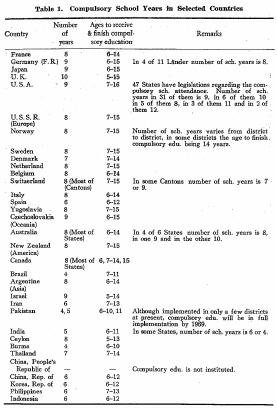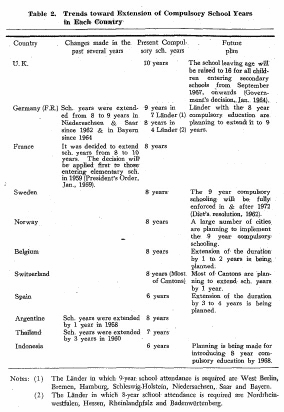| Home > Policy > White Paper, Notice, Announcement > White Paper > EDUCATIONAL STANDARDS IN JAPAN 1965 > CHAPTER1 1 (1) | ||
Two criteria for evaluating the popular spread of education in a nation are the number of years of compulsory education and the percentage of enrollment in the compulsory schools. Under the existing systems in the countries of the world, the United Kingdom ranks at the top with the largest number of compulsory school years, that is, 10, followed by Japan, the United States of America (most of the States), Czechoslovakia and Israel, the number of their compulsory school years being 9. In the majority of European countries, the number is 8, and in Asian and African countries, mostly 4 to 6.
A large number of countries have already decided or are now planning to extend their compulsory school years' duration in the near future, and it is notewortly that the United Kingdom and France, in particular, have already decided their national policy to institute compulsory education of 11 and 10 school years respectively.
The above is only in reference to the full-time compulsory school years. There exists the part-time compulsory school system and, for example, in West Germany and France, it is, as stated later, made obligatory for the compulsory school graduates not entering the full-time secondary schools to attend the part-time schools until they reach 18 years of age. Under the part-time school system, in West Germany, for example, the schooling has, as a rule, been provided at the compulsory basis one day a week for 6 to 8 class hours, though in some Lander (province) it is conducted two days a week(for 12 class hours), and, in France, it is obligatory for the youth employed by business firms and industrial enterprises to receive schooling at institutions of vocational training two or three days a week(for 150 class hours a year). The United Kingdom plans to institute part-time compulsory education in the future as provided by the existing Education Act. The Act provides that compulsory school graduates not entering full-time secondary schools should receive at the institutions of part-time schooling the general and vocational education either one day or two half days a week over a total of 44 weeks a year.


| Back to Top | MEXT HOME |